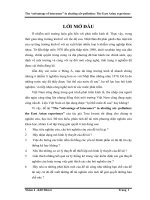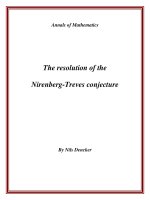Đề tài: The application of marketing in air service of vietnam airlines
Bạn đang xem bản rút gọn của tài liệu. Xem và tải ngay bản đầy đủ của tài liệu tại đây (2.07 MB, 84 trang )
THE APPLICATION OF MARKETING IN
AIR SERVICE OF VIETNAM AIRLINES
TABLE OF CONTENTS
ACKNOWLEDGEMENT.................................................................................................................... III
LIST OF ABBREVIATIONS.....................................................................................................................IV
LIST OF CHARTS AND TABLES............................................................................................................V
INTRODUCTION........................................................................................................................................VI
CHAPTER 1: AN OVERVIEW OF AIR SERVICE MARKETING.................................................1
1.1. WHAT IS AIR SERVICE MARKETING?........................................................1
1.1.1. Special features of air service..................................................................................1
1.1.1.1. Intangibility.........................................................................................................1
1.1.1.2. Inseparability......................................................................................................2
1.1.1.3. Heterogeneity......................................................................................................2
1.1.1.4. Perishability........................................................................................................3
1.1.1.5. Lack of ownership..............................................................................................3
1.1.2. Service and Marketing service.................................................................................3
1.1.3. Marketing in air service............................................................................................4
1.2. PROCEDURES OF DOING AIR SERVICE MARKETING..........................5
1.2.1. SWOT analysis...........................................................................................................5
1.2.1.1. Strengths..............................................................................................................5
1.2.1.2. Weaknesses..........................................................................................................5
1.2.1.3. Opportunities.......................................................................................................6
1.2.1.4. Threats..................................................................................................................6
1.2.2. Doing market research..............................................................................................7
1.2.2.1. Finding out customers needs and wants.........................................................7
1.2.2.2. Segmenting markets...........................................................................................8
1.2.2.2.1. What is market segmentation?..................................................................8
1.2.2.2.2. Benefits of Segmentation..........................................................................8
1.2.2.2.3. The process of Segmentation....................................................................9
1.2.2.3. Targeting market...............................................................................................10
1.2.3. Working out marketing mix strategies..................................................................11
1.2.3.1. Product Strategy...............................................................................................11
1.2.3.2. Price Strategy....................................................................................................13
1.2.3.3. Place Strategy...................................................................................................13
1.2.3.4. Promotion Strategy..........................................................................................14
1.2.3.5. People Strategy.................................................................................................16
1.2.3.6. Physical Evidence Strategy............................................................................18
1.2.3.7. Process Strategy...............................................................................................19
CHAPTER 2: ASSESSMENT OF THE APPLICATION OF MARKETING IN AIR
SERVICE OF VIETNAM AIRLINES.....................................................................................................20
2.1. AN OVERVIEW OF VIETNAM AIRLINES.................................................20
2.1.1. Vietnam Airlines’ history........................................................................................20
2.1.2. The status of Vietnam Airlines in the Region......................................................23
I
2.2. THE APPLICATION OF “MARKETING IN AIR SERVICE” OF
VIETNAM AIRLINES..............................................................................................26
2.2.1. Studying Marketing environments........................................................................26
2.2.2. SWOT analysis.........................................................................................................28
2.2.2.1. Strength..............................................................................................................28
2.2.2.2. Weaknesses........................................................................................................29
2.2.2.3. Opportunities....................................................................................................30
2.2.2.4. Threats................................................................................................................32
2.2.3. Doing market research............................................................................................34
2.2.3.1. How does Vietnam Airlines find out the customers’ needs and wants? . .34
2.2.3.2. Market Segmentation.......................................................................................35
2.2.3.2.1. Broad Segmentation.................................................................................35
2.2.3.2.2. Needs-based segmentations and segment identifications..................36
2.2.4. Targeting Markets of Vietnam Airlines................................................................38
2.2.5. Marketing Mix Strategies.......................................................................................39
2.2.5.1. Product Strategy...............................................................................................39
2.2.5.2. Price Strategy....................................................................................................44
2.2.5.3. Place Strategy (Distribution Network).........................................................45
2.2.5.4. Promotion Strategy..........................................................................................47
2.2.5.5. People Strategy.................................................................................................51
2.2.5.6. Process Strategy...............................................................................................52
2.2.5.7. Physical Evidence strategy.............................................................................53
2.2.6. Evaluation.................................................................................................................53
2.2.6.1. Achievements....................................................................................................54
2.2.6.2. Drawbacks.........................................................................................................55
CHAPTER 3: MARKETING SOLUTIONS TO IMPROVING VIETNAM AIRLINES’
SERVICE.........................................................................................................................................................58
3.1. MARKETING SOLUTIONS............................................................................58
3.1.1. Diversification and improvement of the quality of Vietnam airlines ..............58
3.1.2. Enhancement of air service marketing and promotion activities .....................59
3.2. RECOMMENDATIONS...................................................................................60
3.2.1. For the Government.................................................................................................60
3.2.2. For Vietnam Airlines...............................................................................................62
Company interview (Directly)......................................................................63
Questionnaire....................................................................................................64
CONCLUSION..............................................................................................................................................69
APPENDIX.......................................................................................................................................................74
II
Acknowledgement
This thesis would not have been made possible without the help from
many wonderful people who gave their supports in different ways. To them
I would like to express my deepest gratitude and sincere appreciation .
First of all, I am deeply indebted to my supervisor Asso. Prof., Dr Do
Thi Loan, a senior lecturer and the Dean of the Post Graduate Studies
Faculty of Hanoi Foreign Trade University, for her valuable instruction,
corrections, comments, suggestions and enthusiasm during the development
of my graduation thesis. Her guidance and encouragement have been
invaluable to me and she will always be remembered as the key factor that
influenced my career towards this path.
Second, I am especially grateful to the lecturers of the English Faculty
who provided me with a basic knowledge that is absolutely important in
writing the thesis.
I would also like to extend warmest thanks to all staff of the Vietnam
Airlines and the Civil Aviation Administration of Vietnam (CVVA) who
supplied me with valuable data.
Third, throughout my hard working days, I was blessed with a great deal
of support from my family. I am forever thankful to my admired parents for
their love, understanding, and endless patience and for supporting me in all
my endeavors.
Finally, my last thanks go to all my classmates and former BBE
graduates of the Foreign Trade University, for their encouragement and
support whilst I was working on the completion of this work.
III
List of abbreviations
SWOT
: Strength, weakness, opportunity, threat
ATL
: Above the line
BTL
: Below the line
CAAV
: Civil Association Administration of Vietnam
VNA
: Vietnam Airlines
WTO
: World Trade Organization
SARS
: Serve Acute Respiratory Syndrome
HCMC
: Ho Chi Minh City
AVOD
: Audio/Video on demand
RTW
: Round the world
VFF
: Vietnam Football Federation
7ps
: Price,
Place,
Promotion,
Physical
Product,
People,
Evidence, Process
UK
: United Kingdom
USa
: The United Stated of America
PEST
: Political,
Economic,
Socio-cultural
and
Technological
ICAO
: International Civil Aviation Organization
IATA
: International Aviation Transport Association
CRS
: Computer Reservation System
GPS
: Global Distribution System
IV
List of Charts and tables
Table 2 . 1: Vietnam Airlines' competitors............................................23
Table 2 . 2: Market Share of Vietnam Airlines......................................29
Table 2 . 3: Key competitors and competitive strategies....................33
Table 2 . 4: Roundtrip prices..................................................................37
Table 2 . 5: Evaluating passengers' taste Source: Vietnam Airlines market survey
.........................................................................................................................................42
Table 3 . 1: Action plan for 2006.........................................................................................60
Chart 3.1: Good aspects of Vietnam Airlines’ service..........................65
Chart 3.2: Aspects which VNA needs improving..................................66
Chart 3.3: Passengers’ Favorite Airlines...............................................68
V
Introduction
1. Why I choose this topic
The sixth Party Congress marked a turning point in the process of
economic development of our nation. The country’s reform that began in
the late 1986s and started generating results in the early 1990s created
breakthrough changes in attitudes towards economy and what constitutes a
modern state. What Vietnam has gained from the Doi Moi process is
practically immeasurable. More important than any other things, however,
is that the most significant achievement over the last 20 years was that
Vietnam has successfully changed from its centrally planned economy into
a socialist-oriented market economy.
Thanks to the renovation process and the open door policies of recent
years, Vietnam’s tourism and civil aviation industries have grown rapidly
and recorded encouraging successes. Tourism development has helped the
air industry to grow, and the development of the air industry ensures an
important means of transport for tourism. The number of foreign visitors to
Vietnam in the past few years has continued to increase, and those arriving
by air account for well over 50 percent of them.
At present, the concept of marketing has been widely applied in
manufacturing sector in Vietnam. Nevertheless, the concept of marketing
service in general and marketing air service in particular are quite new. In
fact, many services industries such as airlines have traditionally applied
marketing to their operations less than manufacturing firms. It cannot be
denied that marketing is an important activity for any business that wishes
to become and remain competitive and successful. This is certainly the
case in the rapid changing airlines industry, especially Vietnam Airlines.
However, there remains much room to improve in the application of
marketing to air service of Vietnam Airlines. This is the reason why I
VI
choose this topic for my graduation thesis in the hope of making some
recommendations to improve the efficiency of Vietnam Airlines.
2. Research Methodology
-
Collecting data primary from doing field research, direct interviews
and surveys in Vietnam Airlines and secondary data from text books and
reference books concerned.
-
Using
different
methods
for
study,
comprising
of
analysis,
comparison and generalization.
-
Analyzing based on the marketing rules, processing and summarizing
the collected data.
-
Using online survey via email.
3. Focus of the study
The focus of the thesis is on theoretical framework of marketing service
and marketing air service and the assessment of the application of
marketing air service strategy of Vietnam Airlines.
4. Structure of the thesis
Apart from the introduction and conclusion, the thesis is divided into
three chapters:
Chapter 1: An overview of air service marketing.
Chapter 2: Assessment of the applications of marketing in air service of
Vietnam Airlines.
Chapter 3: Marketing solutions to improving services of Vietnam
Airlines.
VII
CHAPTER 1
An overview of air service marketing
Since 1980s, in the UK more people are employed in the service sector
than in all other sectors of the economy put together. It is the same in the
USA and in most Western economies. In Britain, income from services
contributes more than any other sectors to the Gross National Product, and
income from selling services overseas, called ‘invisible earnings’ plays an
increasingly important role in the balance of trade. Since that time, service
has grown considerably and has received much attention. There are a
number of factors which make services different from physical goods.
Marketing applied in service including has developed accordingly.
1.1. WHAT IS AIR SERVICE MARKETING?
1.1.1. Special features of air service
Unlike goods, services in general and air service in particular cannot be
seen, touched, smelt, tasted, tried on for size or stored on a shelf. They are
intangible. Services own some special features that often have a significant
effect on marketing strategies. These features of services result in
marketing mix decisions that are substantially different from those relating
to the marketing of goods. It must be concerned with factors such as
intangibility, inseparability, perish ability, heterogeneity and ownership
when implementing marketing strategy.
1.1.1.1. Intangibility
Air services are intangible, that means services cannot be seen, tasted,
felt, heard or smelt before the purchase decision. Some marketing authors
even say that the basic difference between goods and services is the
intangibility. Air services do not have real, physical presence as a product
does. For instance, prior to boarding an airplane, airline passengers have
nothing but an airline ticket and the promise of safe transportation to their
Nguyen Thi Thu Hang- A4 – BBE – K41
1
destination. Although services are intangible, the experience customers
obtaining from the service has an impact on how they will perceive from.
What can the customers achieve from the customer service? The answer is
the location, the inner presentation or the environment of where they are
purchasing the service? In fact, a professional working environment, the
hearty welcome of the staff or even the security of the airline will provide
cues as to how well it is run.
1.1.1.2. Inseparability
The
production
and
consumption
of
services
are
inseparable.
Inseparability means that the consumers have direct experience of the
production of the service. The task of satisfying customers for the provider
of a service is in many ways much more difficult than it is for the
manufacture of a product. In service industries everything has to be right
from first time, all the time, any mistake can prove very costly in terms of
losing customers. To take advantage of a bus service, both you and the bus
must make the journey at the same time. Air service is similar, in most air
services; both service providers and the customers must be present for the
transaction to occur. Customer-employees are part of the product. The
simultaneous occurrence of production, purchase and consumption of some
services contrasts starkly with the lengthy time scale which can separate the
production, purchase and consumption of a product.
1.1.1.3. Heterogeneity
Products are often made in batches while services are never identical.
The human element ensures that services will be highly heterogeneous,
which simply means varied. There are so many aviation firms within nation
but how the customers choose among them? In traveling by plane the
service quality may differ from the first time you traveled by that airline to
the second, because the airhostess is more or less experienced. Thus, there
are several causes of variability. First of all, services are produced and
consumed simultaneously, which limits quality control. Secondly, the high
degree of contact between the service providers and the guests means that
Nguyen Thi Thu Hang- A4 – BBE – K41
2
product consistency bases on the service providers’ skills and performance
at the time of exchange. Variability of services poses challenge to the
marketing staff in service sector in general and in aviation in particular.
1.1.1.4. Perishability
Services last a specific time and can not be stored like a product for
later use. In addition, with some services, there is fluctuating demand that
may make perish ability features more serious. Key decisions have to be
made on what maximum capacity level should be available to cope with
demand. Moreover, attention has to be paid in times of low levels of
usages. Short-term policies such as different pricing, special promotions
will be adopted to deal with fluctuations in demand.
1.1.1.5. Lack of ownership
Ownership is not available in service since customer can not own and
store service like a product. When a consumer buys a service he does not
usually receive ownership of anything intangible. Services are used or hired
for a period of time. Buying an air ticket to Australia, say, the service will
prolong within 13 hours but the customers want and expect excellent
service for that long journey. Air service buyers are therefore buying only
access to the air plane or use of seats on the plane.
1.1.2. Service and Marketing service
In general meaning, a product is something that is developed,
manufactured, grown or extracted in exposure to the use of the buyer. A
service, on the other hand, is a non-material equivalent of a good. Service
provision has been defined as an economic activity that does not result in
ownership, and this is what differentiates it from providing physical good.
It’s claimed to be a process that creates benefits by facilitating a change in
customers, a change in their physical possessions or a change in their
intangible assets. The standard definition of a service is that provided by
the American Marketing Association, which says: “Services are activities,
Nguyen Thi Thu Hang- A4 – BBE – K41
3
benefits or satisfactions which are offered for sale or are provided in
connection with the sale of goods”. Then William Stanton modified this
definition
to:
“Those
separately
identifiable,
essentially
intangible
activities which provide want satisfaction and which are not necessarily
tied to the sales of a product or another service. To provide a service may
or may not require the use of tangible goods. However, when such use is
required, there is no transfer of the title to those tangible goods”. And how
about marketing these services?
There are different marketing service definitions by many famous
economists such as Philip Kotler- John Bowen James Makens define
marketing service as “ a social and managerial process by which
individuals and groups obtain what they need and want through creating
and exchanging products and value with other”. In addition, according to
American Marketing Association, marketing service is defined as: “An
organizational function and a set of processes for creating, communicating
and
delivering
values
to
customers
and
for
managing
customer
relationships in ways that benefit the organization and its stakeholders”.
Thus, it can be said that marketing service refers to the marketing of
activities and processes rather than objects, creating benefits and values to
customers.
1.1.3. Marketing in air service
Marketing in air service is part of marketing service bearing the
characteristics of marketing service. Some aspects of air service marketing
can be described as “consumer marketing”, in the sense that they are
targeted at the individual or the family group. Marketing an air service
means converting available seats into revenue seats. It is the revenue
producing side of the air carrier operating statement; it interacts
horizontally across any departments and vertically through all the tiers of
the organizations. In order to be globally known, an airline has to
determine passengers’ needs and wants, formulate strategies and provide
Nguyen Thi Thu Hang- A4 – BBE – K41
4
total customer satisfaction collecting in the same time feed back on its
performance. The marketing objective is to create value for a potential
ticket buyer in open competition with similar offerings. In the airline
industry, the value is created through corporate and brand image. For this
reason, airlines invest huge sums of money in corporate advertising and
developing brands which tend to distinguish from others.
1.2. PROCEDURES OF DOING AIR SERVICE MARKETING.
1.2.1. SWOT analysis
SWOT analysis is a very necessary step that can not be
skipped. It is regarded as an evaluation of the existing of any industry.
SWOT stands for Strengths, Weaknesses Opportunities and Threats. By
studying and analyzing SWOT, the company will have useful data to work
out optimal marketing strategies.
1.2.1.1. Strengths
Every organization has some strength. In some cases this is obvious.
The Strengths, hence, can be considered as anything that is favorable
towards the business, for example Bangkok airways take advantages of the
international network of Thai airways, Eva Air, Silk air, Malaysia Airlines
are strongly potential ones, and Vietnam airline has comprehensive
competition in the market.
To analyze the strengths of an air service, ask the following questions.
The answers will indicate the sources of strength.
Does the air service have strong brands?
Is the air promotion effective?
How has the air service withstood international competition?
What can the air service do better than any others?
Nguyen Thi Thu Hang- A4 – BBE – K41
5
1.2.1.2. Weaknesses
Every organization has Weakness. In some cases, this is obvious; say,
for example, a stricter regulatory environment. In other cases, it is a matter
of perspective, for example, a company has 99% market share and is open
to attack from every new player. For instance, the weakness of Thai airways
is based on schedules of Thai airways International and transit flights of
two different airlines does not have advantage as operating planes of one
airlines, or because of geographical position of airports, Malaysia airlines
is not convenient to have transit flights to Cambodia.
To analyze the weaknesses of a company, ask the following questions.
The answers will indicate the sources of weakness.
Is the air promotion effective?
Will the air service be able to stand price pressure from
competitors?
Is the air service losing out to competitors on the technology front?
1.2.1.3. Opportunities
All organizations have some opportunities that they can gain from.
Keeping in mind what have been listed as the company strengths, it can
now influence the opportunities for the business. These can be seen as
targets to achieve and exploit in the future for example safety and good
service creating a good reputation for the air service.
To analyze the opportunities for a bank, ask the following questions.
The answers will indicate the opportunities.
What is the competitive position of the air service?
Can the air service spread its wings internationally?
Can the quality of operations, services management be improved
without incurring serious cost?
Nguyen Thi Thu Hang- A4 – BBE – K41
6
1.2.1.4. Threats
The final part of the analysis will also be seen as the most feared - the
threats. These could be internal, such as falling productivity. Or they could
be external, such as lower priced international competition. Followings are
some examples of threats that one company can face nowadays: large and
increasing competition, possible relocation costs due to poor location
currently held, end of season approaching (if you depend on hot weather,
etc), existing product becoming unfashionable or unpopular, etc.
To analyze the threats, ask the following questions. The answer will
indicate the threats.
Are international competitors eating away market share?
Are employees adequately trained and motivated?
Is the air service spread too thin?
Successful SWOT analysis should follow simple rules. First, it is
realistic about the strengths and weaknesses of the organization. Second,
analysis should distinguish between where the organization is today and
where it could be in the future. Third, the analysis is specific, short and
simple. Fourth, it is necessary to analyze in relation to other competitors.
1.2.2. Doing market research
1.2.2.1. Finding out customers needs and wants
Any firms or organizations in general and air service in particular
wishing to achieve a profitable and durable penetration of a market must
base on its marketing strategy upon a thorough understanding of customer
needs and wants. Studying customers’ desire is so important for every
business and firms. First of all, it can help the manager establish the basic
requirements of their customers and then assist them in modifying their
product specification as circumstances change. Secondly, it will assist them
in decision-making in a route-based context. Customers’ needs are to get to
Nguyen Thi Thu Hang- A4 – BBE – K41
7
the right destination safety and on time, to be served well, quickly and
enthusiastically. Therefore, basing on the study of customers’ desires,
airline firms day by day design travel products and services that satisfy
customers. Better understand customers’ needs and wants will bring success
for airline firms.
1.2.2.2. Segmenting markets
1.2.2.2.1. What is market segmentation?
The variation in customers’ responses to a marketing mix can be traced
to differences in buying habits, in ways in which the good or service is
used, or in motives for buying. Customer-oriented marketers take these
differences into consideration but they can not afford to design a different
marketing mix for every customer. Consequently, most marketers operate
between the extremes of one marketing mix for all and a different one for
each customer. To do so involves market segmentation, a process of
dividing the total market for a good or service into several smaller,
internally homogeneous groups. The essence of segmentation is that the
members of each group are similar with respect to the factors that influence
demand. A major element in a company’s success is the ability to segment
its market effectively.
1.2.2.2.2. Benefits of Segmentation
Benefits of Segmentation are as follows:
-
Early isolation of a previously unidentified or ignored segment can
create the first- mover advantage.
-
By identifying the requirements of individual segments, an airline
can target those whose distinctive capabilities can serve effectively
and efficiently and whose cost structure allows it to serve most
profitably.
-
Deferential pricing based on the elasticity of different markets
segments allows airlines to capture more revenue that could be
Nguyen Thi Thu Hang- A4 – BBE – K41
8
achieved using a single fare set at a higher level than the more priceelastic segments of demand would be prepared to accept.
1.2.2.2.3. The process of Segmentation
Markets are sometimes segmented intuitively, that is, a marketer relies
on experience and judgment to make a decision about the segments that
exist in a market and how much potential each offers. Others follow the
lead of competitors. The steps involved in segmenting a market in an
organization are:
-
Identify the current and potential wants that exist within a market
-
Identify characteristics that distinguish among the segments
-
Determining the size of the segments and how well they are being
satisfied.
The marketers can base on many criteria to segment the market such as:
-
Demographic segmentation
Age:
Segmenting customers according to age bands is very
common. Children are clearly different to retired people.
Income: For many products income levels can be a sure
discriminator. For instance, a ticket to Hawaii is not suitable to
someone who has low standard of living or low income.
Social class: Segmentation by social class is used very
frequently by consumer marketers. It will often be used instead
of the income and educational variable since it incorporates
aspects of both, together with additional sociological concepts
about dividing people into groups. There are many levels: A.
Upper Middle Class, B. Middle Class, and C1. Lower Middle
Class, C2. Skilled working Class, D. Working Class, E. Those
people who at the lowest levels of subsistence.
-
Geographic segmentation
Nguyen Thi Thu Hang- A4 – BBE – K41
9
-
Benefit segmentation
-
Behavior segmentation
-
Geo-demographic segmentation
-
Lifestyle segmentation (Sustenance driven groups, Outer directed
groups, inner directed groups)
1.2.2.3. Targeting market
Marketers’ chief objective is to locate a group of customers who have an
unsatisfied need which could be met by their company. Segmentation helps
them to move towards this objective because it enables them to analyze and
describe customer’s needs in more detail. To attain their objective they
must take the next step of identifying that particular group or segment
which has an appropriate need and could be met by their company. This is
back to the matching concept. The marketer will try to match the strengths
of the company and its products with the market segment or segments
exhibiting the most suitable needs and priorities. This is the process of
targeting which is the next logical step after segmentation.
When selecting the most appropriate segments to target, the marketer has
the broad strategies to choose from.
Mass Marketing: One product for the whole market. Sometimes
called undifferentiated marketing this involves selling one product to the
entire market, or at least to a very large proportion of it. Mass marketing
has to focus on what is similar in the needs of customers rather than on
what is different and must develop a product and marketing program that
aims to appeal to most buyers.
Selective marketing: Several segments targeted with a different
marketing mix offered to each segment. A selective marketing strategy will
be followed by most medium and large sized companies. It involves
covering several or even all the segments of the market, but in contrast to
mass marketing will offer a different marketing mix carefully designed to
Nguyen Thi Thu Hang- A4 – BBE – K41
10
meet the needs of each segment served. Most of the large car manufacturers
sell a range of models designed to cover most market segments.
Niche marketing: Concentration of the resources on one small part
of the market. Often most suited to the strengths of small companies, niche
marketing involves concentrating the organization’s resources on just one
small segment, or at most a small number of tiny segments. These small
segments are called “niches”. Such a strategy makes a lot of sense for small
companies for two reasons. Firstly, they can concentrate their limited
resources on being one of the best suppliers in a precise market. Secondly,
many niches are ignored by large companies because they are not
considered to represent a sufficiently worthwhile opportunity. The small
company may therefore find that it faces less competition from large
companies in carefully chosen niche markets.
1.2.3. Working out marketing mix strategies
Services are different from product in marketing strategy because of its
own characteristics. In order to manage these features, service marketers
should develop the 7Ps framework. Beside product, price, place and
promotion, now we have three more Ps which are people, process, and
physical evidence. As marketing in air service is a component part of
marketing services, 7Ps are also applied in marketing strategies.
1.2.3.1. Product Strategy
Like manufacturing businesses, good service-providers use marketing to
position strongly in chosen target markets. However, as services differ from
tangible products, they often require additional marketing approaches. In a
product business, products are fairly standardized and can sit on shelves
waiting for customers. But in service business, the customers and front-line
service employees interact to create the service, therefore the skills of the
front-line service employees; service production and support processes
backing these employees are needed.
Nguyen Thi Thu Hang- A4 – BBE – K41
11
A product is anything that can be offered to a market for attention,
acquisition, use, or consumption that might satisfy a want and need. It
includes physical objects, services, places, organization and ideas. Of
course, there must be much more to a product than the glib statement
“whatever we sell”. According to Theodore Levitt, Typically, product in air
service could be divided into four levels:
Generic product
Kotler refers to this first product level as the core product or core
benefit which answers the question: What is the buyer really buying? What
is the core benefit the product offer? All the core benefit should be covered
when selling product to the customers than merely selling features.
Expected product
The customers not only want the core benefit of the products or services
but also expect other additional features from these products and services.
The customers do not just want a flight to right destination but they also
expect a good service, safety, delicious food and an enthusiastic air hostess.
Augmented product
In order to gain an advantage over the competition, suppliers are always
trying to offer something over and above the expected product, since it may
be that little something extra which clinches the sale over a rival product.
The product can be augmented in major ways, by adding a discount-ticket
for the customers under 5 years old, or discount ticket price for special
occasions such as on the Christmas, or summer holiday etc for example.
Potential Product
According to Levitt the potential product includes “Everything that
might be done to attract and hold customers”. Even for the most basic and
mature of products and services, alert marketers have to discover new ways
of marketing the products or services more attractive to buyers. Successful
Nguyen Thi Thu Hang- A4 – BBE – K41
12
companies will therefore manage the products or services very carefully.
They will appreciate that customers buy holes rather than drills, and that
some additional benefits must be provided to attract customers in
competitive markets. Far sighted air service will therefore put much effort
into research and development because the potential product is the one
which will be a winner in tomorrow’s markets.
1.2.3.2. Price Strategy
The prices should be set according to the level of demand in the market
place especially for many services companies since extreme fluctuations in
demand can occur. Their reaction is usually to adopt a policy of price
discrimination, charging high prices during periods of peak demand and
much lower prices during times of slack business. Airlines offer greatly
reduced prices during the special occasions in order to encourage people to
take their holidays out of season.
Price discrimination is practiced by many service businesses. Rail
attracts a lot of businesses with their saver tickets. Airlines have standby
tickets, which can be sold very cheaply to people who are prepared to wait
and take the risk that a sear may not be available.
There is one potential problem which can result from the use of the
price discrimination weapon. If full price customers begin to feel that they
are being treated unfairly in relation to cut price customers they may decide
to switch to the cut price service or to another service provider where their
status will be better preserved. In case first class passenger will expect to
encounter visible benefits in return for their expensive ticket. They will
expect a much higher quality service, failing which they may take their
business to a competing airline.
Nguyen Thi Thu Hang- A4 – BBE – K41
13
1.2.3.3. Place Strategy
As an element of the marketing mix, place or distribution involves those
management tasks concerned with making the product available and
accessible to buyers and potential buyers.
Distributing the product in air service refers to all aspects of the link
between the airline, as producers, and the final customers. Air services are
perishable, and can not be stored for sale later. This affects the distribution
of air service, as they must be marketed in a way that minimizes lost
capacities (ex empty seats on the airplane, or a long waiting list). There are
two types of channel of distribution: direct and indirect distribution. Direct
distribution involves distributing directly from a supplier to the customers;
equally, indirect distribution involves distributing product by the use of an
intermediary.
Airlines sometimes sell direct to the retail customer. However, mostly
they do not. On the passenger side of their business, airlines widely employ
the services of travel agents. Indeed, in many markets, 80% or more of
tickets are sold in this way. On the cargo side, most airlines find that almost
all of their capacity is sold through intermediaries known as air freight
forwarders. There are various channels of distribution but the most common
way is direct dealing with the retail customers which results in obviating
the commission.
1.2.3.4. Promotion Strategy
The fourth “P” in the marketing mix refers to “promotion”, which is the
most visible element in the marketing mix, because advertising and other
promotional activities are the primary means of communication with
tourists in target markets. The purpose of promotion is to create and
increase awareness of a business’ products or services and involves
communicating with prospective clients. There are two main categories of
promotion: above the line and below the line. Above the line ( ATL) is an
advertising technique using mass media to promote brands. Major aboveNguyen Thi Thu Hang- A4 – BBE – K41
14
the-line techniques include TV and radio advertising, print advertising and
internet banner ads, newspapers, magazines, radio, and outdoor activities.
This type of communication is conventional in nature and is considered
impersonal to customers. It differs from Below the line (BTL), which
believes in unconventional brand-building strategies such as direct mail, email, personal selling, sales promotion, public relations, and trade fairs and
exhibitions. Each of promotion elements can influence perceived images of
air service.
Above the line : Advertising
Exhibit 1.1: Thai airways
Source: Thai Airways website
Exhibit 1.2:
Malaysia airlines
Source: Malaysia airlines website
Exhibit 1.3:Virgin Blue Airlines
Source: Virgin Blue Airlines website
Advertising is the activity which includes adverts on the television,
radio and cinema as well as print adverts in newspapers, magazines and
directories. It also includes roadside posters, usually referred to as “outdoor
advertising”. Advertising objectives can be classified by their aim: inform,
persuade or remind. Informative air service advertising is generally used to
increase awareness of new products, features or quantity. For example,
when an airline open a new route, its management often run full page
advertisement informing the market about new service.
Nguyen Thi Thu Hang- A4 – BBE – K41
15
Below the line
In recent years “below the line” activities have been growing at a much
faster rate than “above the line” advertising. “Below the line” includes
many activities such as: Personal selling, Sales promotion and Public
Relations. Personal selling involves an interpersonal influence and
information-exchange process. There are seven general steps in the
personal selling process: prospecting and qualifying, pre-approach,
approach, presentation and demonstration, handling objections, closing, and
follow-up. Personal selling does provide a measurement of effectiveness
because a more immediate response is received by the salesperson from the
customer. Another advantage of personal selling is that salespeople can
shape the information presented to fit the needs of the customer .
Sales promotions are short-term incentives used to encourage
consumers to purchase a product or service. There are three basic
categories of sales promotion: consumer, trade, and business. Consumer
promotion tools include such items as free samples, coupons, rebates, price
packs, premiums, patronage rewards, point-of-purchase. Trade-promotion
tools include discounts and allowances directed at wholesalers and
retailers. Business-promotion tools include conventions and trade shows.
Sales promotion has several advantages over other promotional tools in that
it can produce a more immediate consumer response, attract more attention
and create product awareness, measure the results, and increase short-term
sales.
Public relation is the third promotional tool. An organization builds
positive public relations with various groups by obtaining favorable
publicity, establishing a good corporate image, and handling or heading off
unfavorable rumors, stories, and events. Organizations have at their
disposal a variety of tools, such as press releases, product publicity, official
communications, lobbying, and counseling to develop image. Public
Nguyen Thi Thu Hang- A4 – BBE – K41
16
relations tools are effective in developing a positive attitude toward the
organization and can enhance the credibility of a product.
1.2.3.5. People Strategy
People are the most important element of any service or experience.
Services tend to be produced and consumed at the same moment, and
aspects of the customer experience are altered to meet the “individual
needs” of the person consuming it. Most of us can think of a situation
where the personal service offered by individuals has made or tainted a tour
or vacation.
In addition, people should be seen as a valid and important part of the
marketing mix. If employees go out of their way to give customers
immaculate service at all times, those customers will gradually form a
favorable impression of the company as a “caring company” and this will
be a significant factor in their decision to buy from that company again.
Customers who receive poor service, or simply form the impression that
“this company isn’t really interested in me, they’re more concerned about
themselves” will soon label that company as uncaring, and will begin to
search elsewhere for a supplier. So, it is the reason why this fifth “P” is so
necessary and vital for all businesses. This is seen as the most important
“P” in air service. For instance, British Airways has invested in a major
staff training program called “Putting People First”. Their marketing
research had shown beyond any doubt that staff attitude towards and
treatment of customers strongly affected sales. The objective of the training
program was to help staff concentrates on the two most important aspects
of
company performance-satisfying the customer and beating the
competition. Theodore Levitt puts this in a more erudite way when he
states:
“If marketing is about anything it is about achieving customer-
getting distinction by differentiating what you do and how you operate. All
else is derivative of that and only that”.
Nguyen Thi Thu Hang- A4 – BBE – K41
17
Everybody in the organization must focus on giving the customers what
they want and doing it better than the competition, and in service industries
this often boils down to the way staff treat customers. In service industries
in general even the little things like offering the customers a nice cup of
freshly ground coffee whilst they are visiting the solicitor or being
measured for a new suit can make all the difference.
1.2.3.6. Physical Evidence Strategy
Physical evidence is the material part of a service. Strictly speaking
there are no physical attributes to a service, so a consumer tends to rely on
material cues. There are many examples of physical evidence, including
some of the following:
Packaging
Internet/ Web pages
Paperwork ( such as invoices, tickets and dispatch notes)
Brochures
Furnishings
Signage (Such as those on aircraft and vehicles)
Uniforms
Business cards
Some organizations depend heavily upon physical evidence as a means
of marketing communications, for example tourism attractions and resorts
(e.g. Disney World), air service (ex. Thai airways, British Airways) parcel
and mail services (e.g. UPS trucks), and large banks and insurance
companies (e.g. Lloyds of London).
Physical Evidence is the element of the service mix which allows the
consumer again to make judgments on the organization. If you walk into a
restaurant your expectations is a clean and friendly environment. On an
Nguyen Thi Thu Hang- A4 – BBE – K41
18









